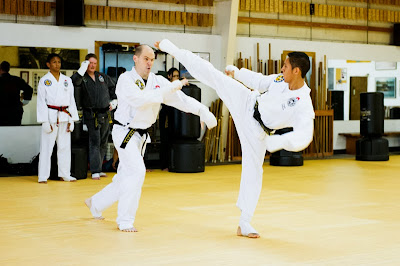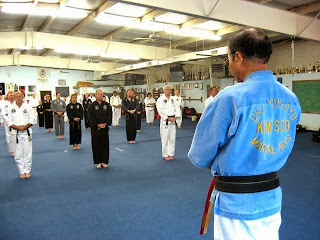Ho-Hub Hyung
A Healing Form for Balance and Health
Brian Hammer
September 2, 2013
“Men are
disturbed not by things but by the views which they take of them.”
- Epictetus,
500 B.C.
“My life has
been full of tragedy, and at least half of it actually happened.”
- Mark Twain
Introduction
Grandmaster
Kim Soo’s contributions to the world of martial arts are significant and ongoing.
His dedicated practice has helped thousands of his students live healthier and
more balanced lives. Modifying martial arts to modern times and purposes, he
has helped to refine the purpose of martial arts practice from its historical fighting
role into a contemporary practice helping those who consistently practice to achieve
health, prosperity and peace. He is a rare teacher, who, after more than 50
years of training and teaching, continues to wear his dobak just about every
day, continues to teach student of all ranks, and continues to refine Chayon
Ryu and his teaching style. His passion remains to help his students live
healthy, prosperous and peaceful lives.
The
pace of 21st Century life can be frantic. With cell phones, tweets,
texts, email and more and more to do, we can get so caught in doing mode, that
many of us neglect taking time to slow down and cultivate peace, calm and
equanimity. Our nervous systems are constantly bombarded with long to-do lists
and the desire to “stay-connected.” Not long ago, human life was more naturally
balanced between activity and rest; noise and quiet. Today, many of us are in
an almost constant busy state.
Grandmaster
Kim Soo emphasizes that martial arts practice must change with the times.
Historically, the purpose of martial arts practice was military, mostly on behalf
of the state. The martial arts samurai was a warrior, expected to put his life
on the line for his country. Martial arts training was designed to maximize power.
The historical martial artist was not concerned with longevity, health and well-being.
Today,
human beings live longer, and care is needed to preserve health. Not only care
for the body, but also for the mind, spirit and nervous system. Grandmaster Kim
Soo came to this realization during the mid-1970s after experiencing a significant
back injury and related health issues, caused in part by his martial arts
practice. He recognized that martial arts practice must change to address the
modern human need for longevity and health.
Lessons from a Back Injury
In
1951, while in the fifth grade, Grandmaster Kim Soo began his martial arts
practice in Korea. Initially he followed the samurai model of hard training and
maximum power. He earned his first-degree black belt in 1954 and began teaching
martial arts full-time in 1963. In 1968, he moved to Houston, Texas and started
the Chayon Ryu International Martial Arts system that now has students and
branch schools all over the world.
During
the mid-1970’s, Grandmaster Kim Soo experienced physical ailments resulting
from years of hard martial arts practice. Recalling that time in his life, he
explains, “I was in terrible shape.” He lost partial hearing, experienced a
blood abnormality, rheumatism, a bad ulcer, and lived in almost constant back
pain from a ruptured disc. He visited various doctors, but nothing seemed to
help. Chiropractors and acupuncture offered no relief and his injuries were not
healing.

It
was during this time that Grandmaster Kim Soo began to reevaluate his martial
art philosophy. Although he appreciated the confidence, strength and discipline
he had gained through his practice, he recognized too that to continue as a
martial artist, he needed to adjust his practice so that it would not cause
injuries. He believed that martial arts practice should align the practitioner
with the principles of health and balance, or Sang Hwal Mu Do (lifestyle
martial arts). Recognizing this need to
transform the practice of martial arts, Grandmaster Kim Soo’s first step was to
heal himself, which he did from 1978-1985.
The
first step in healing himself was realizing that his practice was out of
balance. Hard practice was moving chi throughout his body without returning it
to the danjan and his breathing was out of natural rhythm. If he corrected
these imbalances, he believed his mind and spirit would re-balance and natural
healing would occur.
To
begin this re-orientation, Grandmaster Kim Soo returned to fundamentals,
beginning with Kibon Hyung Il Chol (Basic Form #1). Instead of practicing this form
hard and fast as he had been taught, however, he slowed it down and concentrated
instead on breath, balance, and rhythm. He called this type of form practice
ho-hub hyung (translated as “danjan breathing form practice”). Through focusing
attention on the danjan and on the breath (ho-hub translates as
“inhale-exhale”), Grandmaster Kim discovered the principles of health and
sustainability, and enabled his body to do what the body tends toward naturally,
heal itself.
Although
it took close to seven years, he practiced Ho-Hub Kibon Hyung Il Chol daily,
and one day on a golf course sometime during 1985, he realized that he was
healed. Commenting on why it took so long to heal, he explains that his
seven-year ho-hub practice effectively untied the knot that he had been tying for
30 years.
Ho-Hub Hyung
Now
healed, Grandmaster Kim Soo designed a new ho-hub hyung for his students. Although a slow Kibon Hyung had served its
purpose, he sought to design a new hyung specifically to help students heal
imbalances and reduce injuries.
Late
in the 1980’s, Grandmaster Kim Soo created Chayon Ryu’s unique breathing form –
Ho-Hub Hyung. He conceived this form as the first in a series of four forms he intends
to develop. Ho-Hub’s focus is to develop vital energy (ki), build calm, and
teach mental and physical balance. (The other three forms will emphasize
self-defense, exercise, and offense.) After practicing and refining this
breathing form for a decade, he began teaching it to his students in the late 1990’s.
Ho-Hub
Hyung is intended for any level student. It a form of self-care, meditation and
junbee (being ready), and its purpose is to control breathing and balance the
mind and nervous system. Humans breathe all the time, however, often because of
stress or bad habit, many people develop unhealthy breathing patterns (shallow,
uneven, noisy, and irregular). Ho-Hub Hyung should be practiced with attention
on cultivating a healthier breathing pattern (deep, smooth, quiet and regular).
If
practiced correctly, Ho-Hub Hyung will quiet the mind, bring calm and build chi,
which is good for health and long life. Grandmaster Kim, who is 74 years of age
when this article was written, says that Ho Hub practice has allowed him to
operate youthfully and feel more than ten years younger than his age. He claims
that stress and anxiety are the biggest enemies to youthfulness and health, and
that regular Ho Hub practice has helped him combat both. Most of us will rarely
encounter an external physical attacker. Modern day enemies are internal in the
form of anxiety and its companions, depression, worry, defeat and insecurity. Practicing
Ho Hub Hyung with the right intention and in alignment with the principles of balance
and correct breath is a great way to fight and defeat these internal enemies.
Balancing the Mind
Ho-Hub
Hyung helps balance the mind. For many, one of the unfortunate consequences of
today’s busy lifestyle is an increase in worry, depression and anxiety. There
is a recent Harvard Medical School study that shows that anxiety causes or
contributes to over 90% of disease in America. It certainly dampens wellbeing,
peace and enjoyment. Though, anxiety is completely self-induced. Anxiety is a
byproduct of what Buddhists call “wrong thinking.” This is good news. Because
anxiety is self-induced, we have the ability to take steps to significantly
reduce it.
Anxiety
is essentially what we experience when we make up the possibility of a future
danger in our head. For example, a person might feel anxious because of an
upcoming rank exam, imagining that they are going to forget their form, or fail
to break a board. They might lie awake unable to sleep at night as they replay
the negative future fantasy over and over. Another might fear losing their job
or their health, or anything negative, harmful or embarrassing. These things
have not happened, though imagining them happening in the future causes anxiety
that effects our present wellbeing and enjoyment.

Many
people tend to regularly imagine negative future situations and dangers. This
habit is taxing on the mind, body and soul because imagined harm activates the
same fight-or-flight response as would be activated if we were in real danger. The
result is that the body becomes flooded with chemicals such as cortisol and
adrenaline, which are helpful if we need to fight or flee, but are otherwise
toxic and taxing on our bodies. Over time, the habit of anxiety causes blood
pressure and heart rates to rise, the immune system becomes compromised and the
body and mind become tense and exhausted. A person in this state has increased
risk for every type of injury and disease.
The Human Capacity to
Heal and Prosper
Recognizing
that anxiety is the result of made up danger, to overcome an anxiety habit, we
need a practice that gets us out of our heads and trains us to send a positive
and regular signal to our brain that we are not in danger, when we are in fact
not in danger. Ho-Hub Hyung does just that. If consistently practiced, attention
on controlled breathing – smooth, slow, steady and even – and balanced and
controlled movement, will quiet the brain and send a signal to our nervous
system that we are not in danger. This will automatically counter the effects
of anxiety with a parasympathetic release that will help to restore balance and
promote healing. Over time, consistent practice will lower heart rate and blood
pressure, the immune system will gain strength, and our healing capacities will
be activated.

Ho-Hub
Hyung is a powerful tool to lower anxiety and promote longevity and well being,
especially if practiced daily. Just as brushing your teeth every day will
promote healthy teeth, investing a few minutes per day practicing Ho-Hub Hyung will
unleash the body’s natural capacity and tendency to balance, heal and help
foster a healthy mind and body.
Conclusion
According
to Grandmaster Kim Soo, people are searching for a fixed truth, but truth is
always changing. Even mountains change over time. Recognizing that the role of
martial arts has changed from its martial origins to a more modern need for
balance, and well being, Grandmaster Kim Soo seeks to incorporate the principles
of harmony, balance and proper breathing into Chayon Ryu. Martial arts
practiced in alignment with these principles will support health and longevity.
Anxiety
is a form of “wrong thinking” or “cancer of the brain” that stimulates an
imbalance in the nervous system and manifests as physical, mental, emotional
and psychological disease. Consistent Ho-Hub Hyung practice is a tonic for
anxiety and the consequential ailments that result. Daily practice will teach
our nervous system to restore and maintain balance and harmony.





.jpg)














































